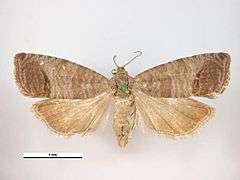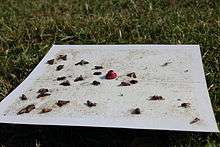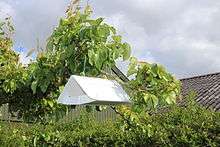Codling moth
| Codling moth | |
|---|---|
 | |
| Male | |
 | |
| Female | |
| Scientific classification | |
| Kingdom: | Animalia |
| Phylum: | Arthropoda |
| Class: | Insecta |
| Order: | Lepidoptera |
| Family: | Tortricidae |
| Genus: | Cydia |
| Species: | C. pomonella |
| Binomial name | |
| Cydia pomonella (Linnaeus, 1758) | |
| Synonyms | |
| |
The codling moth (Cydia pomonella) is a member of the Lepidopteran family Tortricidae. They are known as an agricultural pest. It is native to Europe and was introduced to North America, where it has become one of the regular pests of apple orchards. It is found almost worldwide. It also attacks pears, walnuts, and other tree fruits.
The codling moth is bivoltine in most regions of the USA — in the Pacific Northwest there is a partial third generation.
Description
The codling moth is greyish with light grey and copper stripes on its wings, and has an average wingspan of 17 mm. The females lay eggs on fruit or leaves in summer and the black-headed yellow larvae attack the fruit immediately upon hatching. Each larva burrows into the fruit, eats for around three weeks, then leaves the fruit to overwinter and pupate elsewhere in spring and emerge as an adult moth in summer.[1] Most nourishment is obtained by feeding on the proteinaceous seeds.
 Caterpillar
Caterpillar- Pupa
Control
A prime difficulty in dealing with codling moth infestations seems to lie with appropriate timing. The method of calculating 'degree-days' is often used by orchardists to approximate when a particular pest will reach a particular stage of development during a given season. Since stages of insect development are triggered by the accumulation of a certain amount of heat over time, this calculation involves careful tracking of changes in daily temperature. In the case of codling moths, adults emerging from pupae in bark and other overwintering spaces will mate and begin laying eggs soon after petal fall. For a given moth, this migration can take place within a mere two to three hours. Effective control using any method, therefore, depends crucially on identifying when decisive moments such as these occur.
Chemical control

Codling moth infestations are often managed with pesticides.
Successful synthesis of codlemone, the codling moth female sex pheromone blend, has led to behavior-based monitoring and management. Pheromone traps are used to capture male moths for monitoring and setting biofix, which is the time of first flight for codling moth.
Biofix is used with weather data to run degree day models (see below) which predict with excellent accuracy the phenology of the population in the field, thereby allowing growers to time their management actions to target codling moth when they are most susceptible. A kairomone, which is a feeding attractant, can be used to capture males and females (DA lure). Mating disruption can be used to effectively manage codling moth populations in many cases. Mating disruption involves the use of a pheromone-impregnated release device, typically made of plastic or rubber. Dispensers are distributed throughout the orchard and emit female pheromone at a high, relatively constant rate. The mechanism by which mating disruption affects males is poorly understood; it may increase the time required for males to find females, thus reducing fecundity, or it may simply mask the position of females to searching males, reducing mating substantially.

Another method for control and sampling, 'trunk banding', consists of wrapping a corrugated cardboard strip around the tree trunk. Larvae making their way down the tree to pupate after exiting the infested fruits will use bands as pupation sites. Bands may then be removed and burned.
Recent trials of nontoxic kaolin clay-based sprays indicate an effective alternative means of codling moth suppression may be on the horizon. Codling moths and other pests find leaves and fruit covered in kaolin clay unfit for laying eggs. Tiny particles of the clay tend to attach to their bodies, disturbing and repelling them. In addition, trees covered in kaolin clay can make them less recognizable as habitat to codling moths. Full coverage of trees is necessary to achieve effective suppression. If used only at the beginning of the fruit growing season, kaolin clay often comes off by itself due to wind and rain attrition, leaving fruit clean at harvest time.
Biological control
The codling moth is not a great candidate for biological pest control, as the larvae are well protected within the fruit for the majority of development. However, their eggs are susceptible to biological control by Trichogramma wasps. The wasps deposit their eggs into codling moth eggs, and the developing wasp larvae consume the moth embryo inside.
The most common biological control of codling moth is the application of codling moth granulosis virus (CMGV) in a water based formulation including the granulosis virus, Occlusion Bodies (OBs). CMGV occurs naturally in all major pome fruit growing regions around the world. CMGV is widely used in the commercial and organically grown orchards of Europe and North America. A widely used brand is Virosoft CP4. CP4 is the region of Quebec where the CP4 strain was originally isolated. The CMGV is applied at initiation of egg hatch. The codling moth larvae consume the OB. Next the OB is degraded by the alkaline gut of the codling moth larvae. Then the virus infests the gut membrane linings and reproduces within the larvae. The larvae then stop feeding and eventually die within 3–7 days.
Another candidate for biological control is the wasp Mastrus ridens.[2]
References
- ↑ Royal Horticultural Society page on codling moth|
- ↑ "CHNEUMONIDAE: Cryptinae: Mastrus Förster, 1869". Landcare Research. Retrieved 13 August 2016.
- Darby, Gene (1958). What is a Butterfly. Chicago: Benefic Press. p. 43.
External links
| Wikimedia Commons has media related to Cydia pomonella. |
| Wikispecies has information related to: Cydia pomonella |
- Codling moth on UKmoths
- Codling Moth Information Support System (CMISS)
- UC IPM Pest Management Guidelines - Apple Codling Moth
- Lepiforum.de